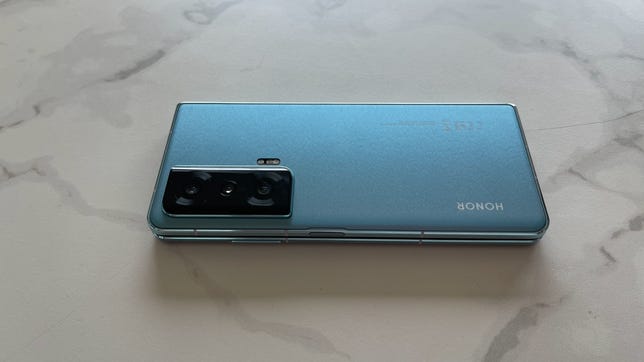Technologies
Honor Magic Vs Review: An Impressive First Try That Almost Rivals Samsung
The Magic Vs foldable phone still needs to improve before it can surpass the Galaxy Z Fold series. But it’s a commendable start.
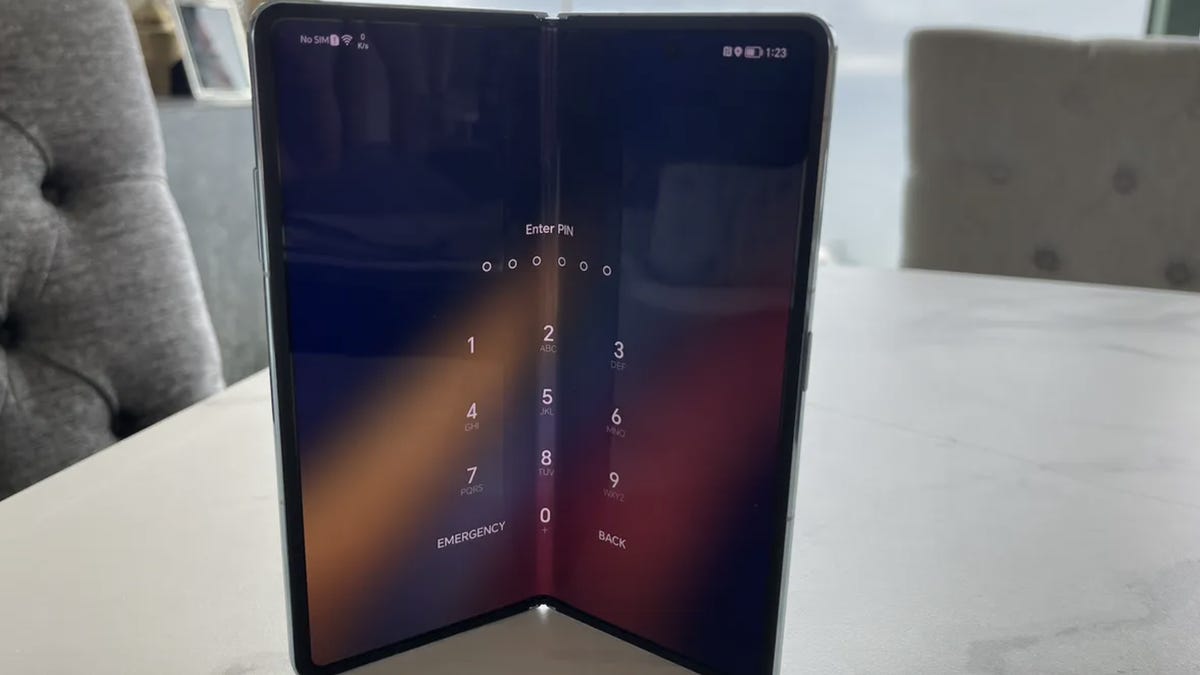
Samsung finally has a new rival in the foldable phone ring: The Magic Vs foldable from Honor, formerly owned by Huawei. Honor revealed in September that it would bring its Honor Vs to international markets after a China release. This week, it showed off its book-style foldable flagship designed for a global audience at the Mobile World Congress in Barcelona.
I had the chance to test the Honor Magic Vs a few days before its launch. I was impressed with the device’s slick hardware, which is lightweight but also allowed the two halves of the phone to fold flat against each other without a gap. The Galaxy Z Fold 4, its biggest rival, still has a wedge-shaped gap when closed even in its newest iteration.
Beyond the standout features, the Honor Magic Vs packs all the specs you’d expect from a 2023 flagship phone into a slick package. That includes a large battery (5,000 mAh), fast charging (66 watts), a powerful Snapdragon 8 Gen Plus 1 processor, and three years of OS upgrades as well as five years of security patches. The only knock I could give in terms of specs is that it lacks the newer Snapdragon 8 Gen 2 chip found in the Galaxy S23 line and OnePlus 11.
Like
- Lightweight for a foldable
- Fantastic battery life
- Fast charging
Don’t Like
- Software doesn’t take nearly enough advantage of the fold
- No official IP rating
- Crease could be less obvious
- Less software updates than Galaxy Z Fold 4
However, it’s not perfect. The crease is more visible and discernible to the touch than other book-style foldables I’ve tested, such as the Oppo Find N and the Huawei Mate XS 2. The phone also lacks wireless charging and an official IP rating for water- and dust-resistance. By comparison, the Galaxy Z Fold 4 has an IPX8 rating for water-resistance.
That said, the Magic Vs starting price undercuts the Galaxy Z Fold 4 by 200 euros, and you also get more storage for that lower price. The Magic Vs starts at 1,599 euros for 12GB RAM and 512GB storage. By comparison, the Galaxy Z Fold 4 starts at 1,799 euros for 12GB RAM and 256GB of storage. There are no current plans for a US release, although the company said a UK launch is expected in June.
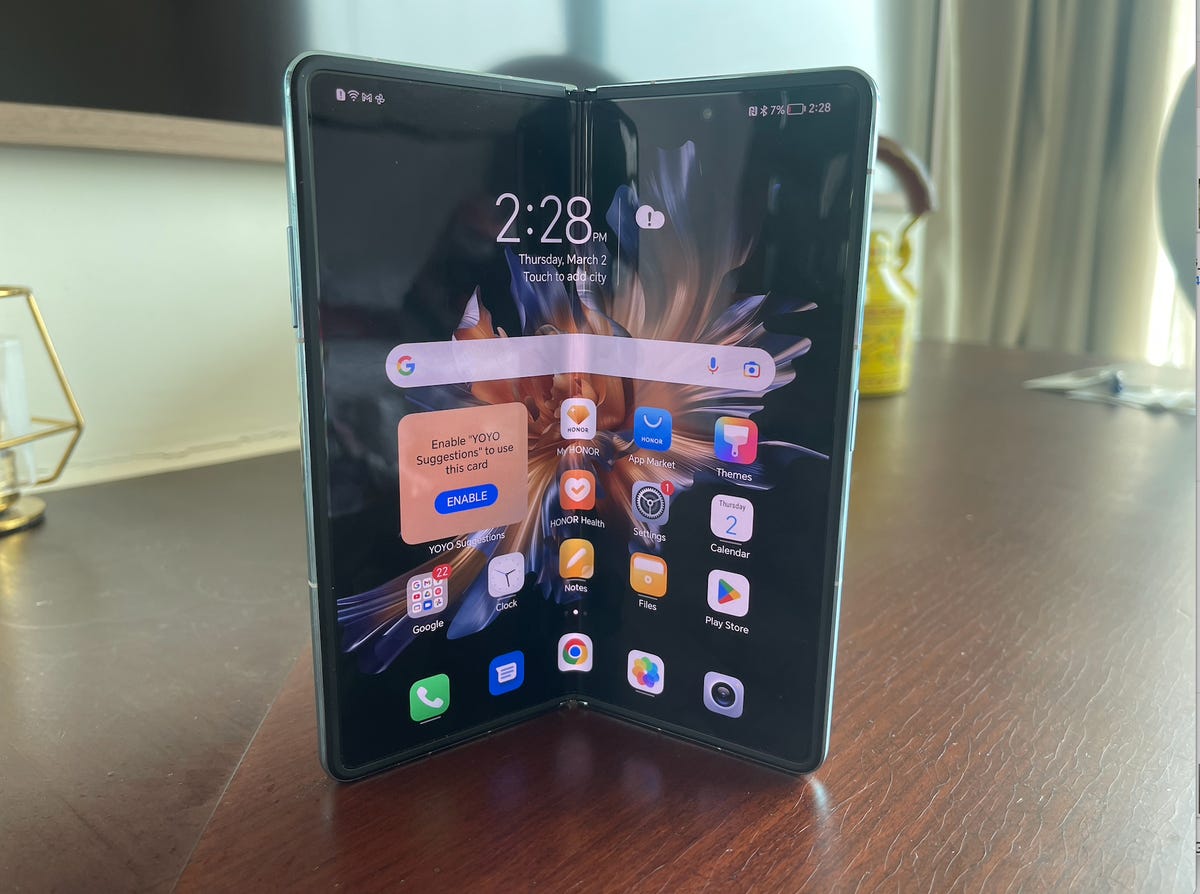

Honor wants the Vs to be a first-class phone first, and a tablet second. The inner screen has a 90Hz display, while the cover screen has a 120Hz display.
Sareena Dayaram/CNETHonor Magic Vs outer display is the focus
The Magic Vs’ headline feature is its bendable display. Like the Galaxy Z Fold 4, it has a cover screen and an interior screen. The outer screen measures 6.45 inches diagonally, while the inner display is 7.9 inches. I found both crisp, responsive and bright, and each screen also folds into the other with no discernible gap.
Unlike Samsung, Honor chose to equip the cover screen of its book-style foldable with superior specs. For example, it has better brightness (1,200 nits vs. 800 nits) and a higher refresh rate (120Hz vs. the inner screen’s 90Hz). For reference, the Magic Vs’ inner screen is a step below the 120Hz capability of the Galaxy Z Fold 4.
Considering this is a foldable phone, I found Honor’s choice to be counterintuitive at first. However, it seems Honor wants this device to be a phone first, and a tablet second. I think this decision helped prolong the battery life of the Honor Magic Vs — which, by the way, was fantastic. (More on that below.)
Honor Magic Vs inner display has an obvious crease
Honor says the Magic Vs has a creaseless display, but that didn’t turn out to be true. You can see and feel the inner display’s crease from various angles. It was immediately noticeable as soon as I opened the phone. I didn’t have to search for it as I have with other foldable phones, such as the Oppo Find N or the Huawei Mate XS 2.
Despite the crease, watching movies and flipping through pictures is fun and immersive. While it didn’t bother me much, such a large crease may be a deal-breaker for some. But it’s a compromise that fans of foldables may just have to learn to live with for now. Samsung’s Galaxy Z Fold 4 still has a crease, though it’s less noticeable than in the past. But Huawei’s Mate XS 2, which has a wraparound-style foldable phone design with one screen, is basically creaseless.
Key to the folding nature of this phone is the hinge. The company said the hinge is crafted with an aerospace grade polymeric material and has fewer components in its supporting structure (just four compared to 94). This helps make the hinge lighter and potentially more durable. Honor claims the hinge can withstand up to 400,000 folds, which means you can expect maybe 10 years of use out of it if you assume 100 folds per day. CNET hasn’t been able to independently verify that claim.
Honor Magic Vs camera
The Honor Magic Vs has three rear cameras, consisting of a 54-megapixel main camera, 50-megapixel ultrawide camera, and an 8-megapixel telephoto camera capable of 3x optical zoom. There’s also a 16-megapixel selfie camera, which is one less front-facing camera than the pricier Galaxy Z Fold 4.
Overall, I was happy with photo clarity, dynamic range, shutter speed and the versatility of the camera. Whether I was in bright, dim or even dark lighting environments, the camera captured crisp, vibrant and accurate photos in a variety of lighting scenarios. That said, this isn’t the best camera. It doesn’t measure up to the iPhone 14 Pro Max for instance, which tends to offer better low light photography. But I guess that’s OK (sort of) since you’re really paying for that fancy display, not the camera module.


This photo was taken through a window. The Honor Vs managed to capture a color accurate image with solid dynamic range.
Sareena Dayaram/CNET

10x zoom example.
Sareena Dayaram/CNET

30x zoom example. This image is relatively lacking in image noise considering how far the camera was zoomed in.
Sareena Dayaram/CNET

This setting was a tricky one to capture since the indoor environment was dim and there was bright light pouring through the windows. Despite this challenge, the camera captured a sharp image with crisp details indoors. Notice the detailing on the wooden floor and the bar seats.
Sareena Dayaram/CNET

The camera does a good job capturing the environment inside the window as well as outside.
Sareena Dayaram/CNET

Notice the sharp detailing of the plate and the contrasts in this photo. It was taken indoors.
Sareena Dayaram/CNET

I took this photo in a moving taxi and think it did a good job capturing motion.
Sareena Dayaram/CNETHonor Magic Vs battery performance
With a 5,000-mAh battery, the Honor Magic Vs has the largest battery of any commercially sold foldable phone. Non-foldable phones, such as the Galaxy S22 Ultra and the Galaxy S23 Ultra, have the same battery capacity.
The Magic Vs made it through most days of testing on a single charge with medium use. I didn’t need to bother charging at the end of the day since I usually had more than 20% remaining. But I charged overnight anyway out of habit.
When I ran a battery endurance test where I watched YouTube videos, scrolled through my Instagram feed, played Genshin Impact and took a 5-minute WhatAapp video call on the cover screen. The battery went from 100% to 86% in those 45 minutes.
The Magic Vs comes with a bundled 66-watt charger, which Honor says will completely replenish a dead battery within 46 minutes. Based on my experience, that claim was true, which means the Magic Vs outshines the Galaxy Z Fold 4 in this department.
The Magic Vs runs on 2022’s Snapdragon 8 Plus Gen 1. In my short time with this phone, the device performed without a hitch whether it was powering multiple apps, running games, streaming YouTube videos or even just switching between apps.


The Magic Vs propped up in a laptop-like position.
Sareena Dayaram/CNETHonor Magic Vs software
The Magic Vs runs Android 13 and Honor’s MagicOS. I’m a fan of MagicOS’ split-screen multi-tasking system, which includes a slide-over menu that you trigger by swiping and holding from the sides. You can multitask with up to four applications, and there’s a split screen mode as well as floating windows. You can also move apps around and resize their windows.
It’s a shame the software doesn’t take enough advantage of the phone’s folding design. I would have loved to see something like Samsung’s Flex mode on the Magic Vs. Even though I could use the phone when it was half-folded and prop it up like a laptop, none of the apps I used, even native ones, that were tailored for that experience. The Galaxy Z Fold 4’s Flex Mode software capabilities let you use the screen when it’s folded at a 90-degree angle.
With the Magic Vs’ slender hardware, solid cameras, fabulous battery life and intuitive multitasking features, Honor has created a solid rival to the Galaxy Z Fold 4. But it’s still tough to recommend the Magic Vs over the Galaxy Z Fold 4 for several reasons: There’s no IP rating, the crease is more visible, its software doesn’t really take advantage of the folding screen and Honor provides fewer software updates than Samsung. Honor made a solid first effort overall, though, and I’m so glad Samsung has more competition.
For more details on how the Magic Vs and the Galaxy Z Fold 4 compare, take a look at CNET’s specs chart below.
Honor Magic Vs specs vs. Galaxy Z Fold 4
| Honor Magic Vs | Galaxy Z Fold 4 5G | |
|---|---|---|
| Display size, resolution, refresh rate | Internal: 7.9 inches, 90Hz (2,272×1,984 pixels) External: 6.45 inches, 120Hz (2,560×1,080 pixels) | Internal: 7.6 inches (2,176×1,812 pixels) External: 6.2 inches HD+ (2,316×904 pixels) |
| Pixel density | Internal: 381 ppi External: 431 ppi | TBC |
| Dimensions (Millimeters) | Folded: 160.3×72.6×12. 9 mm; Unfolded: 160.3×141.5×6.1 mm | Folded: 67.1×155.1×15.8 mm (Hinge) ~ 14.2mm (Sagging); Unfolded: 130.1×155.1×6.3 mm |
| Weight (Ounces, Grams) | 9.23 oz, 261g (orange); 9.42 oz, 267g (black & cyan) | 9.27 oz; 263g |
| Mobile software | Android 13 | Android 13 |
| Camera | 54-megapixel (main), 50-megapixel (ultrawide), 8-megapixel (telephoto with 3x optical zoom) | 50-megapixel (main), 12-megapixel (ultrawide), 10-megapixel (telephoto) |
| Front-facing camera | 16-megapixels | 4-megapixel (under display), 10-megapixel (front cover) |
| Video capture | 4K | 4K |
| Processor | Snapdragon 8 Gen Plus 1 | Snapdragon 8 Gen Plus 1 |
| Storage/RAM | 12GB + 512GB | 12GB +256GB/512GB/1TB |
| Expandable storage | None | None |
| Battery/Charger | 5,000 mAh | 4,400mAh |
| Fingerprint sensor | Side | Side |
| Connector | USB-C | USB-C |
| Headphone jack | None | None |
| Special features | Foldable phone, 3x optical zoom, 66-watt bundled fast-charger | Foldable phone, 30x optical, 30x space zoom, IPX8, 25-watt fast-charging (no in-box charger) |
| Price(USD) | $1,695 (coverted) | $1,800 (256 GB) |
| Price (GBP) | £1,420 (converted) | £1,649 (256GB) |
| Price (Euros) | 1,599 euros (12GB RAM + 512GB) | 1,799 euros (256GB) |
Technologies
Today’s NYT Strands Hints, Answers and Help for Nov. 27 #634
Here are hints and answers for the NYT Strands puzzle for Nov. 27, No. 634.
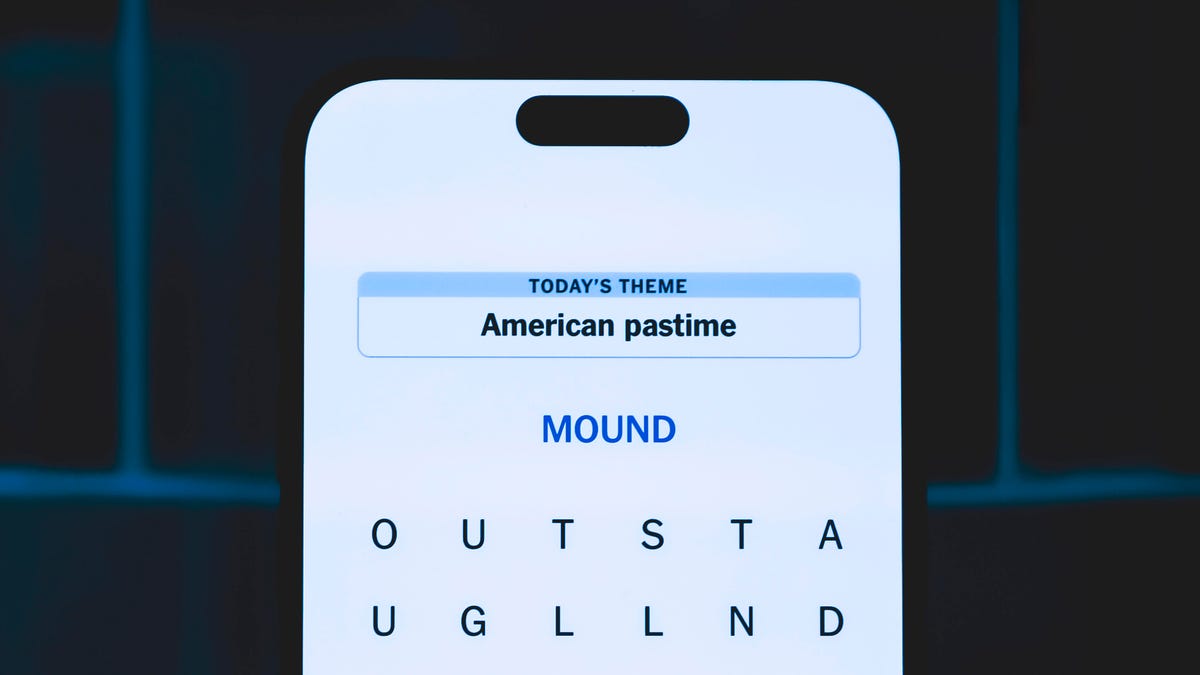
Looking for the most recent Strands answer? Click here for our daily Strands hints, as well as our daily answers and hints for The New York Times Mini Crossword, Wordle, Connections and Connections: Sports Edition puzzles.
Today’s NYT Strands puzzle has a holiday theme. Some of the answers are difficult to unscramble, so if you need hints and answers, read on.
I go into depth about the rules for Strands in this story.
If you’re looking for today’s Wordle, Connections and Mini Crossword answers, you can visit CNET’s NYT puzzle hints page.
Read more: NYT Connections Turns 1: These Are the 5 Toughest Puzzles So Far
Hint for today’s Strands puzzle
Today’s Strands theme is: With gratitude.
If that doesn’t help you, here’s a clue: Today’s the day.
Clue words to unlock in-game hints
Your goal is to find hidden words that fit the puzzle’s theme. If you’re stuck, find any words you can. Every time you find three words of four letters or more, Strands will reveal one of the theme words. These are the words I used to get those hints but any words of four or more letters that you find will work:
- MALE, MALES, DIAL, THEY, HONK, WRIT, ENDS, HEAL
Answers for today’s Strands puzzle
These are the answers that tie into the theme. The goal of the puzzle is to find them all, including the spangram, a theme word that reaches from one side of the puzzle to the other. When you have all of them (I originally thought there were always eight but learned that the number can vary), every letter on the board will be used. Here are the nonspangram answers:
- FOOD, LIFE, FAMILY, FRIENDS, HEALTH, WORK, COMMUNITY
Today’s Strands spangram
Today’s Strands spangram is THANKFUL. To find it, start with the T that’s five letters down on the far-left row, and wind up and across.
Toughest Strands puzzles
Here are some of the Strands topics I’ve found to be the toughest in recent weeks.
#1: Dated slang, Jan. 21. Maybe you didn’t even use this lingo when it was cool. Toughest word: PHAT.
#2: Thar she blows! Jan.15. I guess marine biologists might ace this one. Toughest word: BALEEN or RIGHT.
#3: Off the hook, Jan. 9. Similar to the Jan. 15 puzzle in that it helps to know a lot about sea creatures. Sorry, Charlie. Toughest word: BIGEYE or SKIPJACK.
Technologies
Google’s Pixel Buds Pro 2 Just Hit a New Low of $134 in Amazon’s Black Friday Sale
We’ve never seen these earbuds fall this low, but we don’t expect this deal to last for long.
If you’re in the market for a new pair of earbuds this Black Friday, now’s your chance to get them. We’ve found a great discount on the Google Pixel Buds Pro 2 thanks to the Cyber Week festivities. They’re among the best wireless earbuds as our top pick for Android users and, at just $134, they’re a bargain to boot.
That’s a new low for these earbuds, but do be aware that it only applies to the moonstone color currently. That could change at any moment, though, so make sure to check the price of the other colors if moonstone isn’t your thing. Either way, we don’t expect this price to last for long, so order sooner rather than later.
The earbuds provide noticeably improved sound quality and noise cancellation compared to their predecessor. They’re built with Google’s powerful Tensor A1 chip and designed to offer rich, immersive sound. It’s the first time a Google Tensor chip has been featured in any earbuds and the result is robust active noise cancellation and advanced sound.
The Google Pixel Buds Pro 2 earbuds deliver deep bass with their built-in 11 mm drivers and a new high-frequency chamber for smoother treble. CNET’s audio expert David Carnoy noted that compared to the original Pixel Buds Pro, «there’s more depth and richness to the sound with better overall definition and extension.» Read his full review of the Pixel Buds Pro 2 to get the full lowdown.
These buds also got a design upgrade, with Google making them 27% smaller and 24% lighter to securely fit even more ear types. If you want to wear them during workouts, there’s a twist-to-adjust stabilizer to help lock your earbuds in place while you’re moving around and sweating.
There’s also a conversation detection feature that pauses your music and switches your earbuds to the transparency mode if you start talking. And with an impressive 30-hour battery life, you can listen to all your favorite songs, audiobooks and podcasts for hours on end without having to recharge.
HEADPHONE DEALS OF THE WEEK
-
$248 (save $152)
-
$170 (save $181)
-
$298 (save $131)
-
$199 (save $150)
Why this deal matters
At $134, these earbuds are a great buy thanks to advanced active noise cancellation, impressive sound quality and a lengthy battery life. The current deal makes the Pixel Buds Pro 2 earbuds cheaper than ever. But the deal won’t be around for long, so act fast if you want to take advantage of this awesome discount.
Join Our Daily Deals Text Group!
Get hand-picked deals from CNET shopping experts straight to your phone.
By signing up, you confirm you are 16+ and agree to receive recurring marketing messages at the phone number provided. Consent is not a condition of purchase. Reply STOP to unsubscribe. Msg & data rates may apply. View our Privacy Policy and Terms of Use.
Technologies
Apple Desperately Needs to Launch a Foldable iPhone Flip Next Year
Commentary: Apple is the only major phone company without a folding phone. That needs to change in 2026.
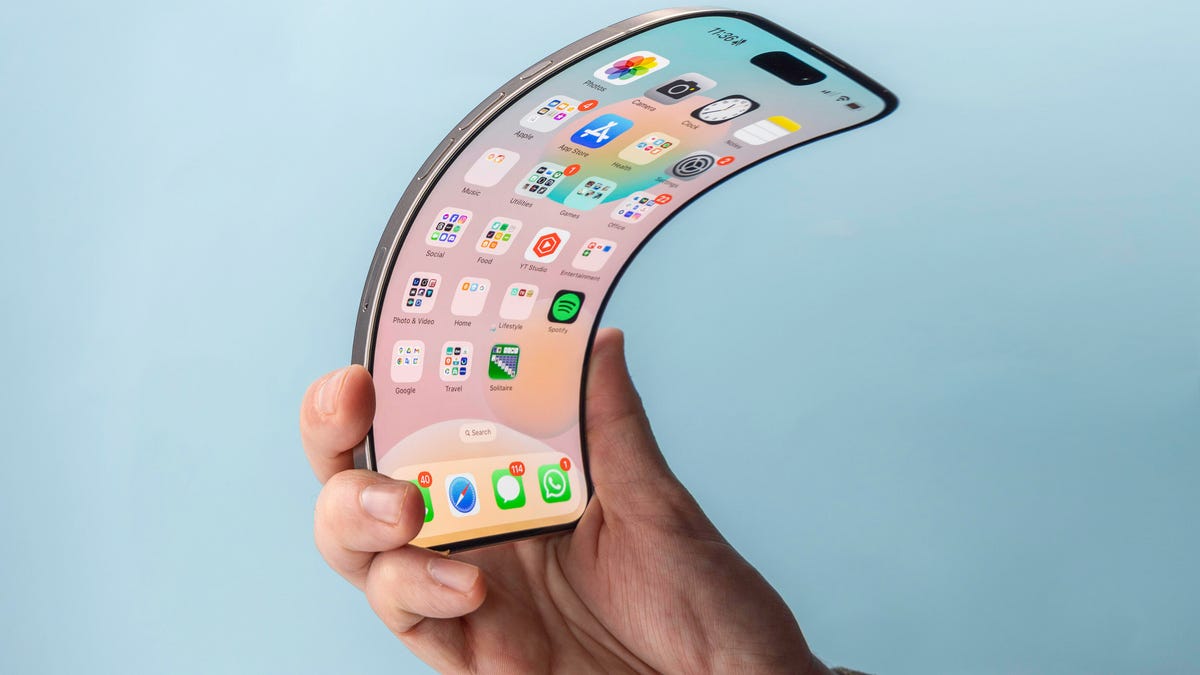
Apple’s iPhone 17 came and went and while we certainly love the iPhone 17 Pro and its vibrant cosmic orange color, I can’t help but be disappointed that the long-rumored foldable iPhone Flip wasn’t part of the company’s September launch event. Most Android phone-makers, including Samsung, Google, Motorola, OnePlus, Xiaomi and Honor are multiple generations into their own folding phone lineups, and it’s beginning to feel like Apple is late to the party. That might be a problem.
Apple dominates in the premium phone category, but foldables — which fit into the premium space in terms of price — are already nipping at its heels, with Motorola telling CNET that 20% of customers buying its Razr foldable jumped ship from Apple. Meanwhile, Samsung is in the seventh generation of its Flip and Fold series. As Lisa Eadicicco discovered during a visit to Seoul, «foldables are everywhere» in Samsung’s home country of South Korea.
With nearly every major Android phone-maker entering the foldable market, Apple risks losing potential customers. It also runs the risk of letting a rival like Samsung become the go-to name for foldables, which could make it harder for Apple to make an impact if it eventually launches its own device. Furthermore, early adopters drawn to foldable tech may be too entrenched in the Android ecosystem by the time Apple’s phone arrives to want to switch to iOS.
Apple is unlikely to be worried. It’s estimated that around 20 million foldables from all manufacturers were sold worldwide in 2023, while Apple reportedly sold 26.5 million iPhone 14 Pro Max handsets in the first half of that year alone. In 2024, foldable sales were flat — and 2025 isn’t fairing much better, according to analysts at CounterPoint Research, although Samsung did report record numbers of preorders for its latest foldable. Clearly, Apple feels it has yet to miss the boat.
Apple has always found success in biding its time, observing the industry and launching its own take on a product when it’s ready. Apple didn’t invent phones, tablets, smartwatches or computers, but it found ways to take existing products and make them more useful, more valuable in day-to-day life and — dare I say — more exciting. It’s why the iPhone, iPad, Apple Watch and Mac lines dominate the market today.
For me, I need to see Apple’s take on the foldable phone. I’ve written before about how disappointed I am in foldables. I’ve been a mobile reporter for over 14 years and phones have become increasingly dull as they’ve converged to become slight variations on the same rectangular slab.
Read more: Best Flip Phone for 2025
Foldables promised something new, something innovative, something that briefly sparked some excitement in me, but several years in, that excitement has dwindled to the point of being extinguished. They are fine products and while I like the novelty of a screen that bends, they’re not a revolution in how we interact with our phones. Not in the way that the arrival of the touchscreen was when we were still pushing buttons to type out texts.
I did hope that Google’s Pixel Fold would be the phone to catapult the foldable forward, and while the recent Pixel 10 Pro Fold — the second generation of Google’s foldable — does offer some great updates, it still doesn’t offer any kind of revolution. Instead, it feels more like a «me too» move from Google. Ditto for the OnePlus Open. So I’m left instead to look toward Apple, a company with a track record for product revolutions, to create a new take on the genre that genuinely drives forward how we use our phones.
That innovation won’t just come from the product design. Apple works closely with its third-party software developers, and it’s that input that would help a folding iPhone become genuinely useful. My biggest complaint around foldables right now is that while the hardware is decent, the devices are essentially just running standard versions of Android with a handful of UI tweaks thrown in. They’re regular phones that just happen to bend.
Few Android developers are embracing the folding format, and it’s not difficult to see why; the users aren’t there in sufficient numbers yet to justify the time and expense to adapt their software across a variety of screen sizes. The multiple folding formats already available mean Android foldables face the same fragmentation issue that has plagued the platform since the beginning. Android-based foldables are simply a more difficult platform for developers to build for than regular phones. Apple would be able to change that, as it proved with the iPhone and iPad.
Given Apple’s close relationships with top-tier developers — not to mention its own vast developer team — I expect an eventual Apple foldable to offer innovations that make it more than just an iPhone that folds in half.
And I truly hope it does. I want to look forward to tech launches again. I want to feel excited to get a new gadget in my hands and feel that «wow» moment as I do something transformative for the first time.
In short, I don’t want to be bored by technology anymore. Apple, it’s over to you.
-

 Technologies3 года ago
Technologies3 года agoTech Companies Need to Be Held Accountable for Security, Experts Say
-

 Technologies3 года ago
Technologies3 года agoBest Handheld Game Console in 2023
-

 Technologies3 года ago
Technologies3 года agoTighten Up Your VR Game With the Best Head Straps for Quest 2
-

 Technologies4 года ago
Technologies4 года agoBlack Friday 2021: The best deals on TVs, headphones, kitchenware, and more
-

 Technologies4 года ago
Technologies4 года agoVerum, Wickr and Threema: next generation secured messengers
-

 Technologies4 года ago
Technologies4 года agoGoogle to require vaccinations as Silicon Valley rethinks return-to-office policies
-

 Technologies4 года ago
Technologies4 года agoOlivia Harlan Dekker for Verum Messenger
-

 Technologies4 года ago
Technologies4 года agoiPhone 13 event: How to watch Apple’s big announcement tomorrow

